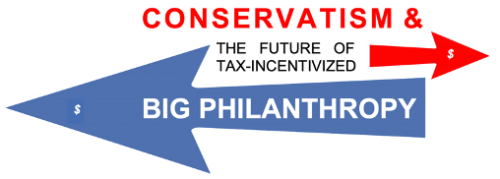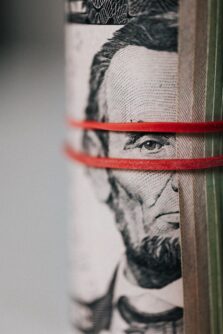It has reconstituted the very system that Alexis de Tocqueville once famously lauded Americans for not having. Meaningful reform will be of the hatchet, not the scalpel variety.
Part of The Giving Review’s online symposium, “Conservatism and the Future of Tax-Incentivized Big Philanthropy.” A shorter version of this article originally appeared in The Chronicle of Philanthropy on January 24, 2023.
Some years ago, I was sitting in the Lillian S. Wells Foundation quarterly board meeting just off Fort Lauderdale’s sun-drenched Los Olas Boulevard, when our foundation chairwoman asked: How much are we required to give away this year?
The question didn’t strike me then the way it does today. It was routine. I’ve heard it asked—and have asked it myself—a hundred times during the past 20 years as a foundation director, nonprofit executive, and philanthropic advisor.
Like all charitable foundations, we were required by the U.S. Internal Revenue Code to distribute five percent of the foundation’s assets to qualified nonprofit organizations annually. So, naturally, we asked: How much are we required to give away this year?
Most Americans, though, never ask that question. Most Americans wouldn’t give it a second thought. Why would they?
The overwhelming majority of taxpayers don’t itemize their federal income taxes or claim the charitable deduction. Most Americans will never start their own foundation or open a donor-advised fund (DAF). Most don’t have a tax accountant, philanthropic advisor, or private account at Northern Trust.
Long before the Revenue Act of 1917 created a tax deduction for charitable contributions, Americans gave to charity and formed voluntary associations of every kind. The genius of American philanthropy, it is often said, is that nearly all Americans, of every income level, give. But the tax-exempt portion of the Internal Revenue Code is not for all Americans.
For most Americans, charitable giving begins by asking: How can I help? What do they need? How can I make a difference? They would never think to ask: How much am I required to give away? That’s the animating question of tax-incentivized Big Philanthropy, not charity.
American charity, in other words, pre-dated the creation of the Internal Revenue Code and the federal income tax. It didn’t need to be “incentivized” into being by government tax policy. Charitable exemptions in the Internal Revenue Code are for those few Americans who practice philanthropy, not the many who practice charity. Tax-incentivized Big Philanthropy is the business of giving that begins by asking: How much are we required to give away?
When I think about the future of Big Philanthropy, I am struck by the great and growing chasm between the very few whose giving is calculated by asking How much are we required to give away? and the great many whose charity begins by asking How can I help?What does this division tell us about the future of Big Philanthropy?
The Big Philanthropy legislative buzzsaw
The formidable body of tax-exempt law, policy, and regulation created and overseen by lawmakers over the past 100 years provides the framework for tax-exempt Big Philanthropy. Enacted with the ostensible intention of keeping America’s charitable sector independent, I wonder today: Whom do these laws serve? What have they protected? Is America better off because of them?
In November 2020, philanthropists Laura and John Arnold announced an initiative to increase charitable giving by making modest changes in the laws governing tax-incentivized Big Philanthropy, the Initiative to Accelerate Charitable Giving. The Arnolds previously won plaudits for signing The Giving Pledge in 2010 and for their “impactful” giving along a broad range of public policy areas, like prison reform and scientific integrity. The Philanthropy Roundtable feted Laura Arnold as one of “10 Exceptional Women in Philanthropy.”
At the height of the Covid-19 pandemic, many believed that charitable foundations, with nearly $1.5 trillion in tax-advantaged assets, could distribute more. After all, one of the arguments in favor of perpetual charitable trusts and tax-advantaged foundations with large endowments is that they can be mobilized in times of crisis. The Arnolds agreed. Their initiative set out to increase giving by promoting greater accountability and fixing inefficiencies in charitable-giving tax laws.
The Arnolds’ initiative includes, among other changes, a provision that would disallow foundation family members from counting their salaries and travel expenses toward their foundation’s annual charitable-payout obligations. Contributions to DAFs—charitable-giving holding accounts that allow donors to retain advisory privileges over how funds are distributed—would not count toward annual foundation payout requirements. The five percent of assets that tax-exempt charitable foundations are required to payout annually would have to be put directly into charitable purposes.
The Initiative to Accelerate Charitable Giving would also compel gifts to DAF holding accounts to be distributed within 15 years to receive an up-front tax benefit—which they get under current law, but with no time limit. Presently, donors can contribute to a DAF and receive an immediate tax deduction but are under no obligation to distribute the funds in the year they receive the deduction.
Legislation influenced by the Arnolds’ initiative currently languishes in Congress. But to Big Philanthropy, the Arnolds’ proposal was dead on arrival. Nonprofit executives, think-tank leaders, university faculty, DAFs themselves, policymakers, and fellow philanthropists—from both the political right and left—panned the Arnolds’ initiative and related legislation. The Wisconsin-based Bradley Foundation president Richard Graber dismissed the initiative as “a solution in search of a problem.”
Of the 85,000 private, family, and community foundations in America, the Initiative to Accelerate Charitable Giving website lists fewer than 15 foundation members. The liberal Council on Foundations and its member groups oppose legislation based on the Arnolds’ proposal because it adds “complexity and costs for foundations and donors.” Writing to Congress in 2021, the Philanthropy Roundtable, representing “64 other free-market and conservative organizations,” warned that “this proposal would severely hamper Americans’ ability to give to causes they care about.”
The Arnolds’ initiative has run into the same Big Philanthropy buzzsaw that shredded the 2017 Trump tax cuts. A flurry of reports, studies, press releases, op-eds, and countless interviews and podcasts foretold the collapse of charitable giving if the Trump administration’s proposal became law. Americans would become “less generous,” a Time headline emblazoned.
The Tax Cuts and Jobs Act nearly doubled the standard deduction to offset the cost of lower tax rates for all taxpayers. The University of Pennsylvania’s Wharton School of Business warned that raising the standard deduction would give taxpayers fewer incentives to give, because fewer would itemize and claim the charitable deduction. The Wharton School warned that Donald Trump’s tax cuts would lead to a “$22 billion drop in charitable giving.” That did not happen.
In 2019, Americans contributed $450 billion to charity, the second-highest amount ever at the time in nominal, inflation-adjusted dollars. “People donate when they have more after-tax income and when the economy is strong,” the Tax Foundation reported in 2020, “not when they are induced to do so by the tax rate.” In other words, lower taxes and a good economy have a bigger influence on most American charity than the charitable tax exemption.
Rise of the professional philanthropic class
Why such bipartisan opposition among America’s elites to changes in the tax-exempt portion of the Internal Revenue Code? Why is it that nonprofit organizations funded by George Soros, the Gates Foundation, and the Koch brothers walk in lockstep when it comes to opposing changes to tax-incentivized Big Philanthropy? Why do ideological, policy, and political differences evaporate when it comes to charitable tax advantages for wealthy Americans?
The tax-exempt portion of the Internal Revenue Code allows donors to make tax-advantaged charitable contributions to various giving vehicles, including charitable trusts, foundations, and DAFs, among others. It generally requires those same funds to be distributed to qualified tax-exempt nonprofits. Nonprofits may in turn use their tax-exempt dollars to advocate, educate, and even lobby in support of tax-exempt charitable laws that, in turn, inure to the benefit of the nonprofit’s major donors. In other words, philanthropists can use their tax-advantaged funds to advocate for greater tax-incentivized charitable laws through the tax-exempt nonprofits they support. And they do.
This circle of self-serving charitable giving has helped to spawn a permanent, parasitic, and professional philanthropic class that knows who butters its bread: Big Philanthropy. America’s professional philanthropic class—which includes employees of universities, nonprofits, think tanks, philanthropies, journalists, DAFs, investment banks, financial and philanthropic advisors, and charitable foundations—all drink from the same government-regulated trough of tax-advantaged charitable funding, creating a conflict of interest that is baked into the Internal Revenue Code’s charitable tax exemptions.
This conflict of interest helps explain why the professional philanthropic class often stands uniformly opposed to even modest changes to charitable tax laws. Its opposition arises from the conflict inherent in the charitable tax-exempt system. The livelihood of the professional philanthropic class is dependent on Big Philanthropy’s tax-advantaged charitable grantmaking. Because nonprofit grant recipients have a financial interest in advocating for favorable charitable policies, tax exemptions have been a powerful means of accelerating the growth of Big Philanthropy. This structural conflict of interest also renders Big Philanthropy’s research, education, and advocacy as suspect as that of Big Tobacco in the 1970s.
The professional philanthropic class has been successful in preventing legislative changes adverse to Big Philanthropy’s interests. Its success, however, is also its weakness. Things impervious to change or self-reform are often in decline, even when they appear strong.
In a diverse, stratified, and rapidly changing society, Big Philanthropy stands ossified, out of place and outside of time, like the towering Tyrannosaurus Rex in the concourse of the Chicago Field Museum. At the very moment when its size and influence seem greatest, Big Philanthropy is weak.
Despite the triumph of tax-incentivized Big Philanthropy, America’s nonprofit or independent sector grows stagnant and increasingly dysfunctional. America’s government-regulated regime of tax-incentivized philanthropy has remained about two percent of gross domestic product (GDP) since the 1970s. Year-to-year giving fluctuates, to be sure. But changes in monetary policy, fiscal policy, tax policy, charitable tax exemptions, the general health of the economy, generational giving spikes, or innovations in charitable giving vehicles have not moved charitable giving beyond the roughly two-percent-of-GDP threshold since President Gerald Ford was in the Oval Office. Events from recent history are instructive on this point.
Although the Federal Reserve added the equivalent of Sweden’s entire GDP every year for the past 15 years to the U.S. economy, ballooning its balance sheet from $900 billion in 2008 to nearly $9 trillion today, charitable giving as a portion of GDP declined. It went from 2.2% in 2008 to 2.1% in 2021. The largest intergenerational transfer of wealth in U.S. history of $68 trillion from aging Baby Boomers to younger generations beginning in 2007, likewise, has not grown the charitable sector as a portion of GDP. What about the great innovation in giving vehicles hyped by the professional philanthropic class as “democratizing philanthropy,” DAFs? Despite DAF accounts swelling in number from 181,000 in 2008 to more than 1 million today, DAFs have had exactly zero effect on total charitable giving as a portion of GDP.
Tax-incentivized charitable giving laws, whatever their intended purpose, have not incentivized charitable giving beyond two percent of GDP for over 50 years. It seems reasonable to ask, therefore, if charitable-giving tax policies suppress giving, acting as a charitable giving ceiling rather than a floor. Big Philanthropy gives as much as it is required to give away each year, not more, to maximize tax advantages. Tax benefits for wealthy Americans, rather than “tax incentives” that promote giving, seem to be the de facto purpose of the exempt portion of the Internal Revenue Code.
Big Philanthropy is a racket: end charitable exemptions
While the independent sector languishes decade after decade in two-percent-of-GDP purgatory, the past 15 years boomed for America’s most wealthy. For the first time in American history, the top one percent of Americans owns more assets than the country’s entire middle class. Their increased wealth is insulated by tax-incentivized charitable giving.
For most Americans, however, this same stretch of time since the Great Recession represents lost years in terms of wealth creation and preservation. Most Americans have seen a slow but sure decline in wealth, a dramatic rise in debt, and more recently a drop in savings, even in an economy awash with cheap money, soaring stock valuations, and spectacular increases in real-estate values.
In protecting the underlying logic of tax-incentivized Big Philanthropy, the philanthropic professional class has served its patrons well, but not the bulk of Americans. The rise of Big Philanthropy has contributed to a historic retreat in public trust in nonprofit institutions.
Household giving to charity across all racial and ethnic groups is also in steady decline. For those households that do give, “the average amount given is going down for all but the wealthiest families,” according to The Generosity Commission.
Americans grow weary of Big Philanthropy’s special tax privileges. The Internal Revenue Code says emphatically that Bill and Melinda Gates are treated differently under the law because they give more money to a private, tax-advantaged foundation (which they control). They’re philanthropists; most Americans are merely charitable.
Unequal treatment through charitable tax-exemptions promotes division in America. Tax-incentivized philanthropy doesn’t serve most Americans. It contributes to the concentration of wealth through charitable tax exemptions and incentives. And it requires voluntary associations of every kind to petition the privileged philanthropic class for patronage and funding.
Americans are right to chafe at the rise of tax-incentivized Big Philanthropy, for it has emerged over the past 100 years as a simulacrum of the medieval European spoils and patronage system that revolutionary Americans once rejected and warred against: a system where, in order to get things done, the many must petition the few—government and the aristocracy—for recognition, license, and funding.
Tax-incentivized Big Philanthropy, in other words, has reconstituted the very system that Alexis de Tocqueville once famously lauded Americans for not having in his Democracy in America. The rise of Big Philanthropy has contributed to the stagnation of voluntary associations, broad-based charitable giving, and civil society. It has helped to create a popular loss of faith in the American system, its institutions, and its leadership and managers. Big Philanthropy is fundamentally un-American.
The future of tax-incentivized Big Philanthropy in America is a story of decline at the very moment when its influence seems boundless. Because conflict of interest is baked into the Internal Revenue Code’s charitable tax exemptions, the prospect for meaningful self-reform seems remote. Whenever the specter of reform materializes, like with the Arnolds’ proposal, the professional philanthropic class mobilizes, resists, and conjures hollow counter-reforms like the above-the-line charitable deduction, adopted in the 2020 CARES Act.
Following passage of the CARES Act, charitable giving in 2021 declined by 0.7% after adjusting for inflation. In a year when the S&P 500 gained 26.9% and home prices increased by 18.8%, an expanded charitable deduction had zero impact on giving. This was predictable, of course, because everybody knows that for the overwhelming majority of Americans, the charitable deduction is meaningless. An above-the-line charitable deduction is a cynical Beltway strategy to protect tax-incentivized Big Philanthropy by redirecting the reform conversation away from meaningful change. It’s a game.
When the world is viewed through the inherent conflict-of-interest prism of tax-incentivized charitable giving, it’s difficult to see, much less acknowledge, that 100 years of charitable tax exemptions have arrested the development of the independent sector. It’s difficult to see that most Americans are nonplused by tax-incentivized Big Philanthropy: unmoved by encomiums to wealthy donors served up by the professional philanthropic class at awards ceremonies and in news outlets funded by tax-incentivized charitable dollars. When you’re living in the tax-incentivized charitable-giving conflict-of-interest bubble, you simply don’t see what’s apparent to most Americans: Big Philanthropy is a racket.
This is why meaningful reform of the tax-exempt sector will be driven by populists outside of Big Philanthropy instead of from conflicted parties within it. These reforms will be of the hatchet, not the scalpel variety, embodying the spirit of the Trump tax cuts, not the Arnolds’ modest proposal; and they will come from both the political right and left. Occupiers. Tea Partiers. Democratic socialists. Trumpers.
Policymakers and the professional philanthropic class should stop playing cat-and-mouse Beltway games that never address the inherent conflict of interest baked into tax-incentivized Big Philanthropy. Instead, policymakers should embark on a bold new project: remove the conflict of interest inherent in tax-incentivized Big Philanthropy by ending charitable tax exemptions of every kind. Under this regime, wealthy Americans can emulate the giving habits of the 90% of Americans whose charitable giving is made with after-tax dollars. Removing the charitable-exemption lid will inaugurate a new era of greater giving, and the independent sector can finally live up to its name.






